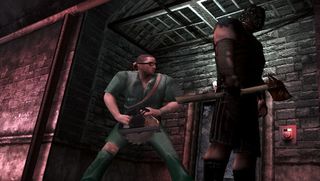"An erotic adventure aimed squarely at 12 year old boys" Reviewer Ellie Gibson on Lula 3D (2006)

Lula 3D is one of the better examples of why theres such a collective stigma around Adults Only games: Many of them just arent that adult in the first place. Lula itself is part of a series that includes such titles as Lula: The Sexy Empire and Wet Attack: The Empire Cums Back. From Riana Rouge to Singles: Flirt Up Your Life, all too often AO games seem to focus less on, yknow, being good, and more on shoving boobs in your face. The half-hearted attempts at humor or maturity almost always fall flat, and what youre usually left with is a broken game and some personal embarrassment. Its a shame, truly, because most adults deserve better.
"Help people make informed entertainment choices" - Manhunt 2 pits Take Two and Rockstar against the ESRB again (2007)

As the Hot Coffee incident showed us, Rockstar is certainly no stranger to Adults Only-controversy. Only two years after the San Andreas hubbub, the UK dev found itself in hot water again with 2007s gruesomely violent Manhunt 2. The second installment in the action horror series was initially slapped with the AO rating, marking one of the few times (like the aforementioned Thrill Kill) that a product received the label purely for violence.
Since Manhunt 2 didnt involve digital naughty time, the uproar surrounding it was slightly more muted than usual, but still fairly sizable. Publisher Take-Two clashed with the ESRB again, saying things like we believe the process of rating videogames is to help people make informed entertainment choices and not to limit them (via the Escapist), and all that jazz. In the end, it didnt matter. Rockstar went back and censored the console versions of the game in order to avoid the usual AO trappings and have their game released on the console, the PC version kept the AO rating, and the typical anti-AO stance found in virtually all aspects of the industry could not be budged. The judgment was harsh enough that it even made some companies, like Condemned and F.E.A.R. dev Monolith, feel pressured into removing potentially questionable content from their own games.
Communicating intensity ESRB president Patricia Vance on the purpose of AO rating (2007)

One of the most frequently asked questions about AO games has to be just what makes its content so different from the scores of violence, sex, and the like already found in their M-rated counterparts. After all, theres only a one year difference between the age required to buy a Mature game (17) and an Adults Only one (18). And if retailers, console makers, and publishers are so averse to the few branded AO, why even have a separation in the first place?
According to ESRB president Patricia Vance, the real usefulness comes in communicating intensity. It indicates that the content in the game is more intense than what is typically found in an M-rated title, Vance told Kotaku around the time of the Manhunt 2 controversy, and the rating is there because that distinction is useful to consumers. Shes frequently compared the M-to-AO relationship to the movie industrys R-to-NC-17 difference as well, and while such responses dont exactly solve the fact that AO games are effectively dead on arrival, it gives at least some insight on a topic thats been swept under the rug over the years.
Brown vs. Entertainment Merchants Association affirms games free speech (2011)

The landmark Supreme Court ruling in the case of Brown vs. Entertainment Merchants Association marked yet one more legal victory for the gaming industry in its seemingly eternal struggle with local and federal governments over Mature and AO content. On the surface, it revoked a California state law enacted in 2005--right around the time of the Hot Coffee fiasco--that prohibited the sale or rental of loosely-defined violent video games to minors without parental supervision. The bill would have also required violent games to bear a two-inch-by-two-inch sticker on their front covers labeling them as such.
Sign up to the GamesRadar+ Newsletter
Weekly digests, tales from the communities you love, and more
Perhaps more importantly to gamers, the ruling saw the Supreme Court declare, in a 7-2 decision, that video games were subject to full First Amendment protection. In his majority opinion, Justice Antonin Scalia stated that depictions of violence in media have never been subject to government regulation, that there was no definitive link between violent games and youth, and that no government could claim a free-floating power to restrict the ideas to which children may be exposed, be they games or not. Video games, it was believed, were to have the same rights and expressive value as books, television, or film. Obviously, many gamers and game companies lauded the decision. It wasnt a complete Get Out of Jail Free card, but it was a big step forward for the industry at large.
A good thing for the system Vance on the prospects of future AO games (2012)

Well complete our bloody, squishy trip through AOs history with some hope for the future. In an interview with Gamasutra earlier this year, ESRB president Patricia Vance said that, as games as a whole shift from physical stores to digital ones, it may be very possible that there will be greater acceptance of an AO rating going forward.
And by the way, I think that would be a good thing for the system, Vance continued. It's very frustrating that publishers can't release AO product, in many cases. So long as future AO games treat their consumers like adults (and not pent-up hornballs), its hard to find fault in her statements. The powers that be will always have one eye focused squarely on video games, it seems, but its certainly encouraging to hear that there may yet be light at the end of this dark, messy AO tunnel.
The mature future

The future of AO games might be unknown, but as the medium evolves so will the ratings that govern them. Maybe, in the future, game publishers and developers will be more open about creating games that garner the rating. Otherwise, well, we'll just have to settle for brief nudity and hyper-violence, instead of sex and super-hyper-violence.
And if you want more ESRB-related news, check out gaming's most violent duos and instances of Nintendo's censorship of Japanese games in America.
Most Popular

